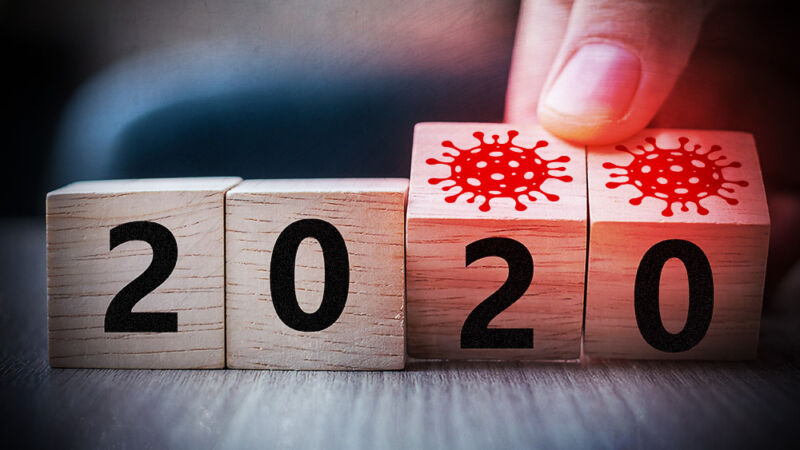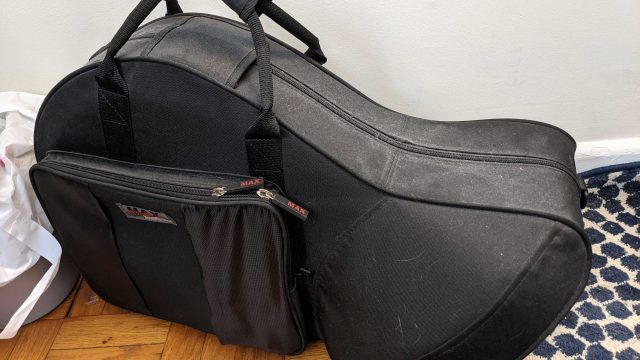Before and after —
COVID-19, one year later: Ars staff looks back on… truly something else.
John Timmer
–

Aurich Lawson / Getty Images
We’re roughly at the one-year point of the global COVID-2 pandemic—Ars’ initial explainer on the virus first published on March 8, the World Health Organization declared a pandemic on March 11, and the US declared a national emergency on March 13. As we all grapple with the realization 12 months have passed, various anniversaries are being marked. There are lots of major mileposts to mark; moments that made the severity and global scale of the pandemic clear, or were the first signs of the new reality of social isolation, remote schooling, and offices created out of any available spare space.
For many of us at Ars, the big mileposts were abstract—things that happened to other people or society as a whole as we continued to work from home. But as we talked about the experience of last March, each of us seemed to come up with a different moment when the severity of the pandemic really clicked.
What follows is a collection of the experiences that drove home the severity of COVID-19 to each of us—the moments we knew things weren’t going to be the same. Feel free to add your own in the comments.

Enlarge / The author’s French horn, gathering dust for the last year.
Kate Cox
Expelled
From where we sat, the world ended on Friday the 13th last March. That was the last time my daughter, then in first grade, would set foot inside a school for the next year.
We had a feeling it was coming. The first COVID-19 case was identified in Virginia, in the next county over from where we live, on March 7. My husband and I had taken the kids to brunch that morning, and you could already feel a strange unease in the air. Brunch in one of our regular haunts didn’t feel unsafe, exactly—but what if it was?
My daughter’s school had its annual International Night (one of the highlights of the year) on March 11, and all through Monday, Tuesday, and Wednesday, discussions were raging in the PTA and parent groups on Facebook. Nobody could decide if it was safe to go, if the event should be canceled, or if the home-cooked food served by parent volunteers would make anyone sick.
In the end, I went with my daughter while my husband and our toddler son stayed home. The photos and videos I have on my phone of her and her best friend joining in a huge, joyous Guatemalan folk dance in the school gym that night are the last pictures I have from “the before.”
“Please keep your music”
The wind ensemble I play in rehearsed on Tuesday night, as usual, and our spring concert was scheduled for Thursday, March 12. At lunchtime Thursday, the conductor sent us an email promising the concert was still on. But just before 5:00 pm, he sent another: the rumors we’d been hearing were true, and the schools were about to close for “maybe four weeks.” That included the high school where we were scheduled to perform and the middle school where we rehearsed. The concert was canceled.
“Please keep your music until we meet again,” he wrote. “I am not quite sure when that will be.”
Within a half-hour, the district notified parents that all after-school activities and out-of-hours uses of school buildings for the remainder of the week were being canceled immediately. Following March 13, the school buildings would be closed for the next three weeks, and the administration would re-evaluate after spring break.
Spring break came and went. April, May, June, and the rest of first grade came and went. Summer came and went, with parks and pools closed and camps shuttered. Fall came once more—but school did not.
There is, at least, a hopeful postscript. Our daughter returned to the classroom just under a year from the day she left it—on March 3, 2021.
—Kate Cox, Tech Policy Reporter
The show won’t go on
I truly realized that SARS-CoV-2 was going to be a big deal at the end of February last year. My first inkling was on February 26. I had flown to Vancouver for an event and, while making my way through the non-Euclidian immigration line at YVR, I noticed that an inordinate proportion of the travelers coming in from Asia were wearing face masks.
Things really started sinking in a couple of days later, just before returning to DC. At breakfast on February 28, the buzz was whether or not the Geneva auto show was going to take place, following the first reports of deaths in Lombardy, Italy. Later that morning, Volkswagen made the decision to cancel the planned trip to Geneva for the show. Within a week, the remaining trips on my calendar were canceled one after another.
I’ve not set foot on a plane since February 28, 2020.
—Jonathan Gitlin, Automotive Editor
Hearing it from a friend
I’m generally pretty news-savvy and had been following the developing COVID-19 story in a general way since the beginning of 2020. When my spouse returned from an Australian speaking tour March 1, he mentioned that concern about the coronavirus Down Under was much greater than in the US, and he thought the bug might become serious. “We should probably start stocking up on some basic necessities, just in case.” So we did. But somehow we still weren’t mentally prepared for how quickly things were about to change.
Over the next 10 days, I visited the set of The Orville, where everyone joked about what the new greeting protocol might be in lieu of hugs and handshakes, usually opting for a coy touching of the elbows. We had brunch with friends, had a couple of date nights, started planning a weekend trip to Vegas… and all the while, case numbers in the US were beginning to rise sharply and spread beyond the initial hot spots. Talk of impending lockdowns swirled.
But the stark reality of what that meant didn’t hit me until I went to two matinee screenings on Friday (The Hunt) and Saturday (Bloodshot), March 13 and 14, respectively. LA’s pending shutdown was officially announced as I exited the Americana theater in Glendale Friday afternoon. When I showed up at the Americana for my Saturday afternoon screening—usually the most popular time slot—it was almost completely deserted, like a ghost mall. I was one of only three people at the screening. Clearly other Angelenos got the message more quickly than I did. I just wish I’d taken the opportunity to watch better movies.
“We’re not going to do everything right”
We dutifully stayed home and followed all the best-practices guidelines for the next two weeks. But even then—EVEN THEN—hope sprang eternal. I mean, this couldn’t last more than a month or so, right? RIGHT? Then my husband had a sobering podcast interview with an epidemiologist friend of ours, who spelled out in great detail just what the world was facing. “If we do everything right, we might beat this by June,” she told him. “But we’re not going to do everything right. You should be prepared for this to last a year, maybe a year and a half.”
I still check in with her Twitter feed from time to time, because every single prediction she has made over the last year has been dead accurate, right down to the patchwork nature of devastating COVID-19 outbreaks in the Midwestern states and more rural areas.
It has been a long, difficult year of social distancing, of wearing masks to run errands or go for walks, of no travel, of no dining out, of no dentistry, and of no congregating with friends and family. Humans are an adaptable species, and we’ve all adapted as best we can. We made good use of Zoom, multiple streaming platforms, and food-delivery services, and we have expanded our repertoire of weekend home-cooked meals. We even set up a makeshift home workout area in our bonus room. But still, the year has taken a heavy emotional toll.
Adding to that toll has been the frustration of watching something that should have brought the country together drive everyone further apart—because certain unprincipled factions thought they could benefit from politicizing the situation and spreading rampant misinformation. A large swath of Americans decided to believe them and behave selfishly. We’ve been grieving over not just the half-million (and counting) lives lost, but also over the loss of a sense of shared sacrifice to achieve a common good.
—Jennifer Ouellette, Senior Writer

